
Subwoofer Array Workshop
Meeting held at The Paramount Theatre, Seattle Washington
January 29, 2001

Meeting held at The Paramount Theatre, Seattle Washington
January 29, 2001
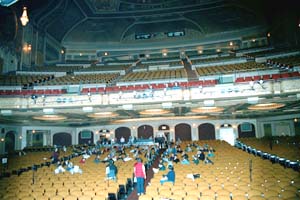 |
This is the view into the hall from the stage. The room seats about
3000. The theatre dates to 1928 and was designed by reknowned theatre architect
B.
Marcus Priteca. The theatre's heyday was motion pictures and the vaudville
era. In later life it reverted to a first-run movie house and then a rock-and-roll
venue. In the 1990s, the theatre was sold, placed on the Historic Register,
and a significant restoration effort mounted to once again evoke the wonders
of a 1920s Movie Palace.
http://www.pstos.org/history/priteca.htm http://www.cr.nps.gov/nr/travel/seattle/s14.htm |
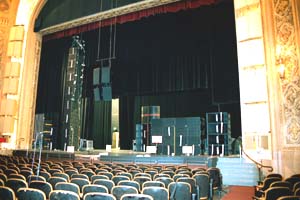 |
View of the stage, from the audience. This was the initial setup. From left to right: 1x4 array of BassMaxx, 1x15 tower of SB1000, the house's MSL4 and CQ array (flying), 2x4 array of ServoDrive, 2x4 array of SB1000, 1x4 array of ServoDrive. |
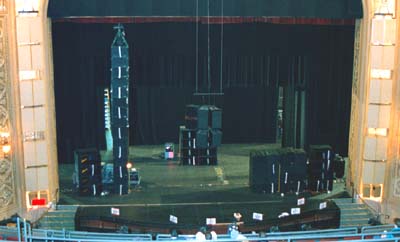 |
View from the balcony. The 'stripes' that can be seen in front of many of the cabinets are pieces of a lightweight silk-like fabric used to visualize the acoustic output of the box. |
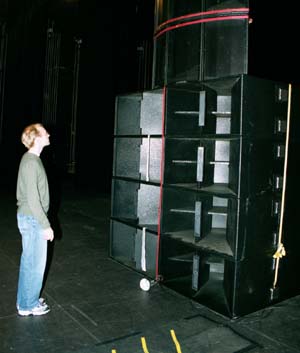 |
Christopher Whitt (who also travelled furthest to attend) standing
in front of the ServoDrive BassTech 7 2x4 array. There were eight of the
Sound Physics Labs SPL-td1 trap boxes used for the mid-high spectrum of
this array.
There were two components to the listening workshop. One component involved listening to the same speaker cabinets arrayed in different locations and configurations. The other component demonstrated the ServoDrive BassTech 7 2x4 array and the BassMaxx array as alternative subwoofer cabinet and driver designs. These cabinets were powered by Crown MacroTech 3600 amplifiers.
|
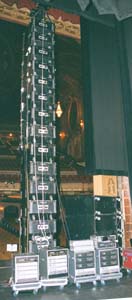 |
The tower of 15 SB1000 cabinets standing tall. Fifteen was deemed to
be as tall as safety and prudence dictated. The top eight boxes are flown
from a chain hoist, and the bottom seven were ground stacked. This also
allowed listening to only the eight flown boxes, and the seven ground-stacked
boxes.
The four amp racks shown powered the two different arrays. One uses Crown MacroTech 5000 amplifiers, the other uses QSC Powerlight 6.0 amplifiers. (two different sound companies supplied the SB1000s) Note that only one Powerlight was used to drive four of the BassMaxx cabinets. We gave the rest the day off.
|
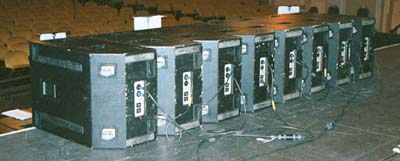 |
A 8x1 linear array laid on the stage floor. We also tried the same
array configuration, with the speakers located on the audience floor (directly
in front and below this location).
The impact from this configuration was impressive, but there were significant timbre differences between the main floor and the balcony seats. |
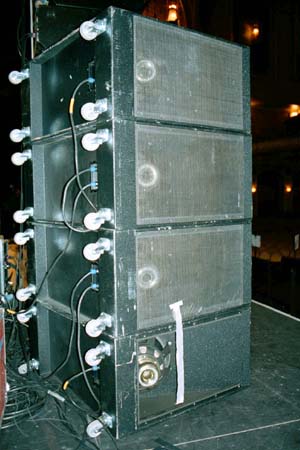 |
The BassMaxx 1x4 array. This is a 3/4 view showing the rear of the
box and one side. Note the exposure of the rear of the single 18" driver
to the environment.
There were two components to the listening workshop. One component involved
listening to the same speaker cabinets arrayed in different locations and
configurations. The other component demonstrated the ServoDrive BassTech
7 2x4 array and the BassMaxx 1x4 array as alternative subwoofer cabinet
and driver designs.
|
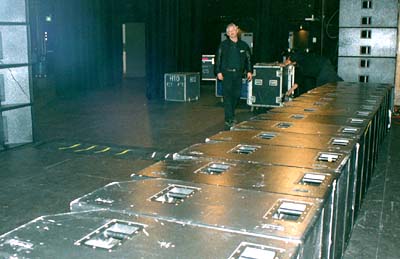 |
Mark Carlson of Carlson Audio contemplates a long line of SB1000 cabinets. |
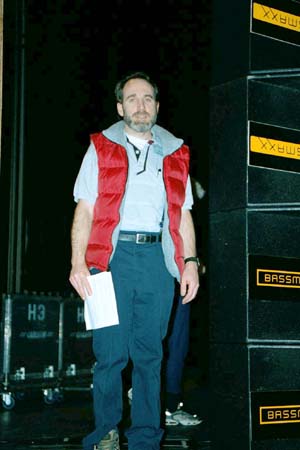 |
PNW Section Chair Rick Smargiassi surveys the assembled mass of bass lovers. |
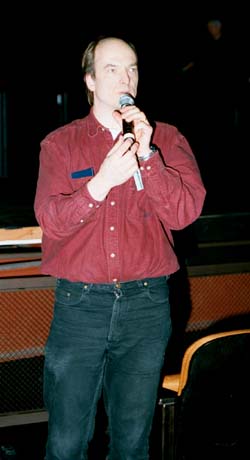 |
Meeting co-coordinator Dan Mortenson tells the attendees what we're about to do and fields questions from the floor. |
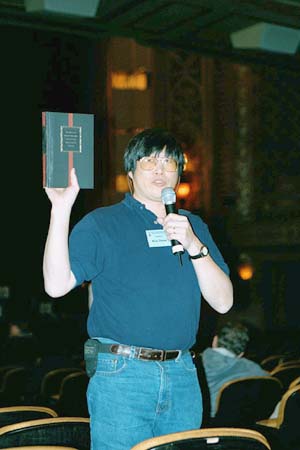 |
Meeting co-coordinator Rick Chinn displays a copy of Leo Beranek's classic text, Acoustics. Harry Olson's book, Acoustical Engineering was also mentioned. Both books contain the fundamental line array descriptions and mathematical analysis. |
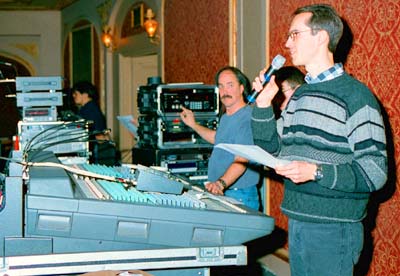 |
David Lee of Rhino Acoustics gives a description and listening test
of the BassMaxx speakers, using their own program material.
Later in the evening, when we compared the BassMaxx and ServoDrive systems we used same program material as used through the other arrays. Mark Anderson, head sound engineer for the Paramount is in the background, ready to start the demonstration. |
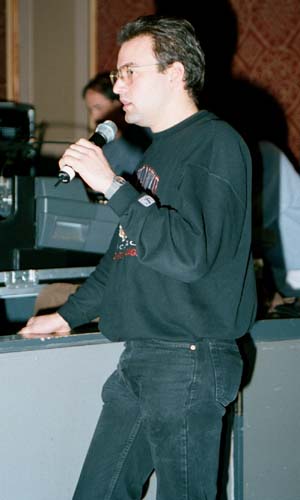 |
Chris King, representing Servodrive, describes and demonstrates the Servodrive transducers using the same program material as used through the other arrays. |
| Photos by Paul Smargiassi | Descriptive text by Rick Chinn |
Return to Meetings Archive page.
Return to PNW Homepage.
Last modified November 4, 2001.